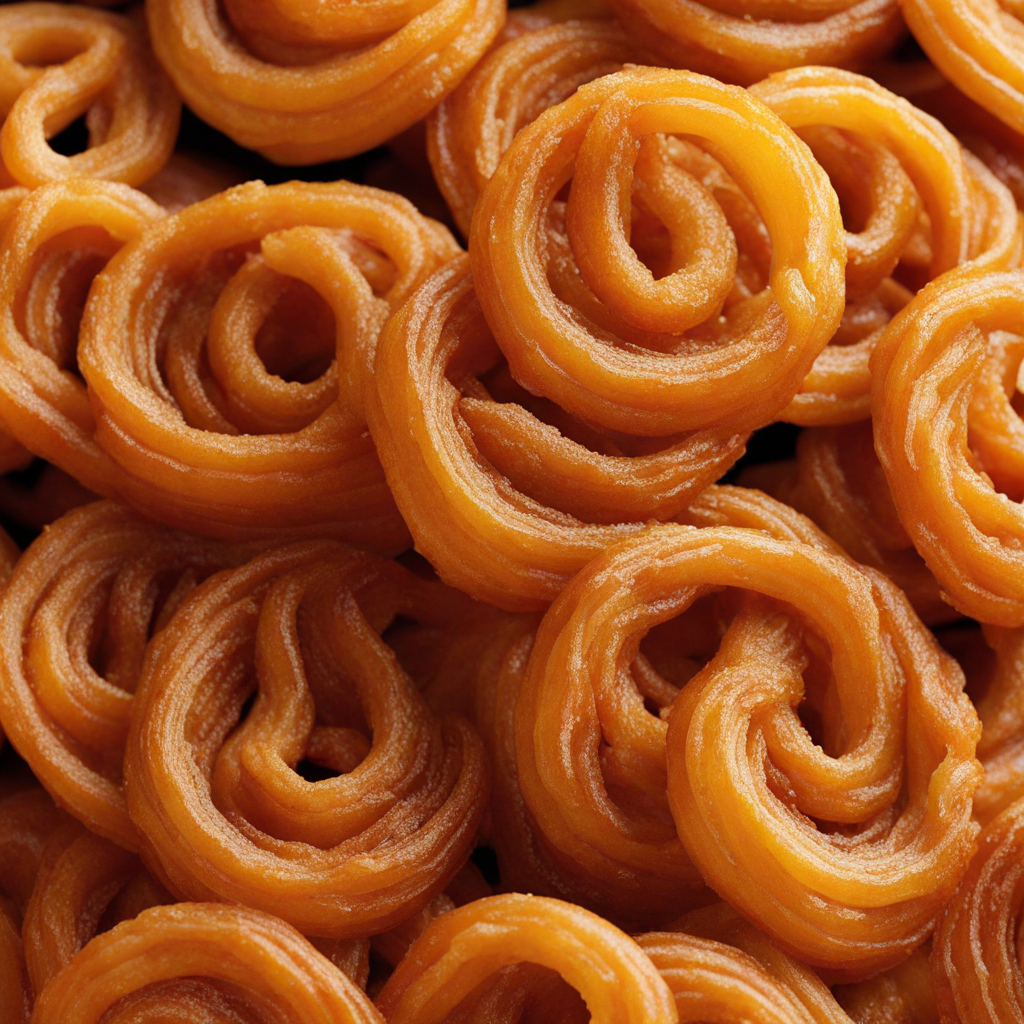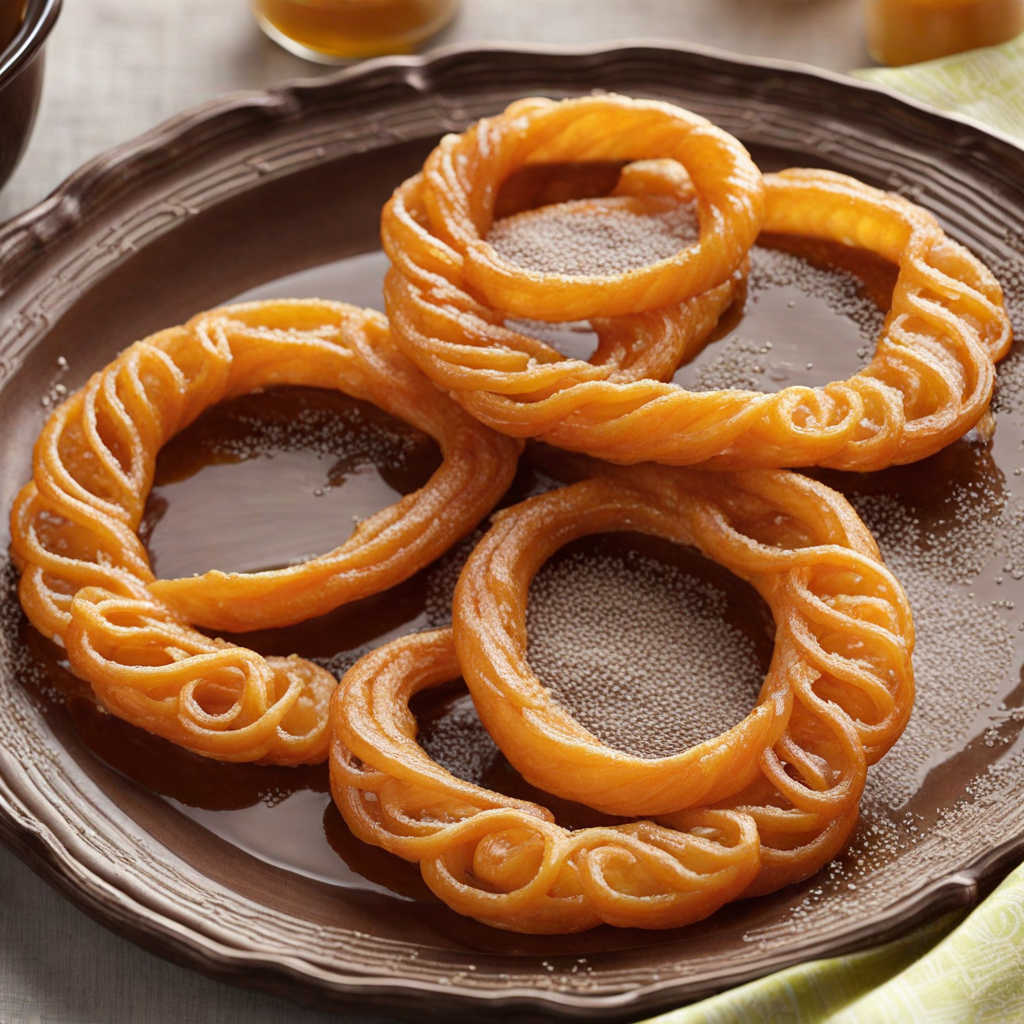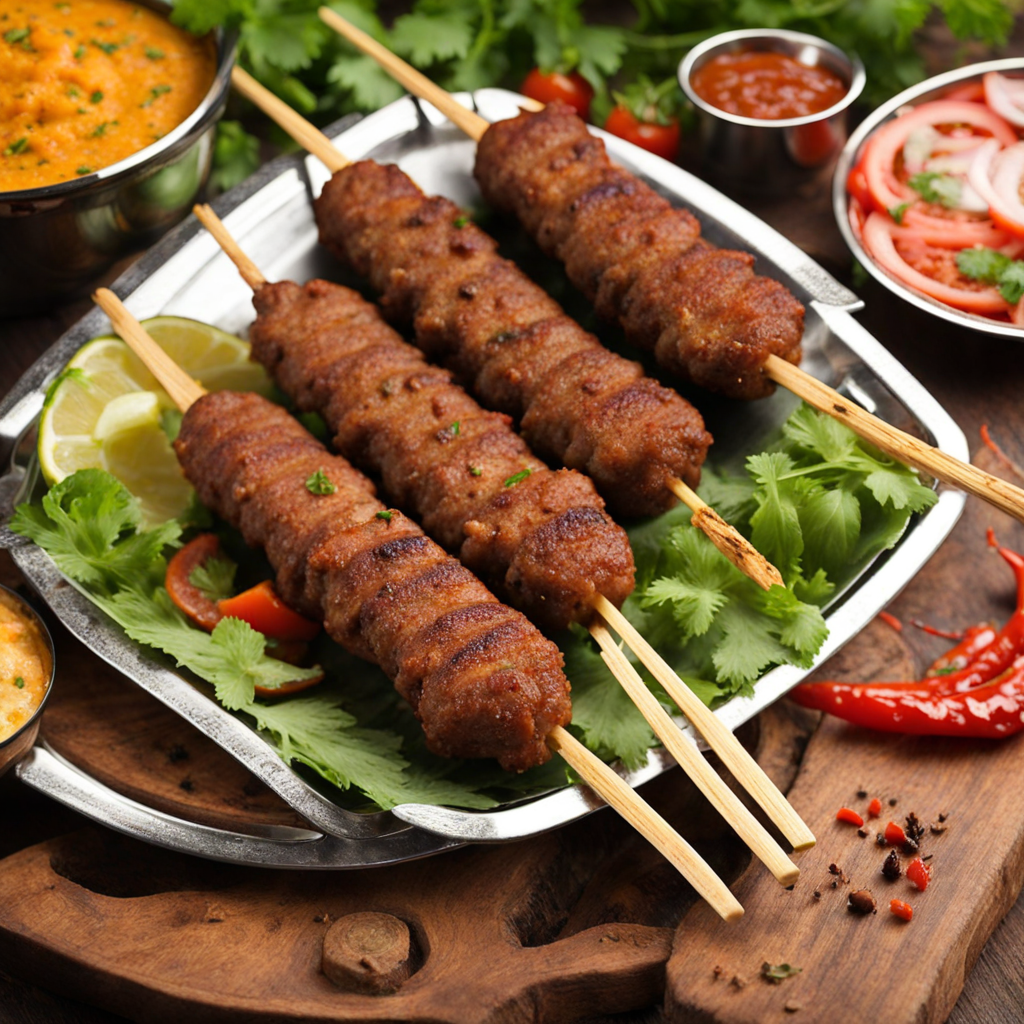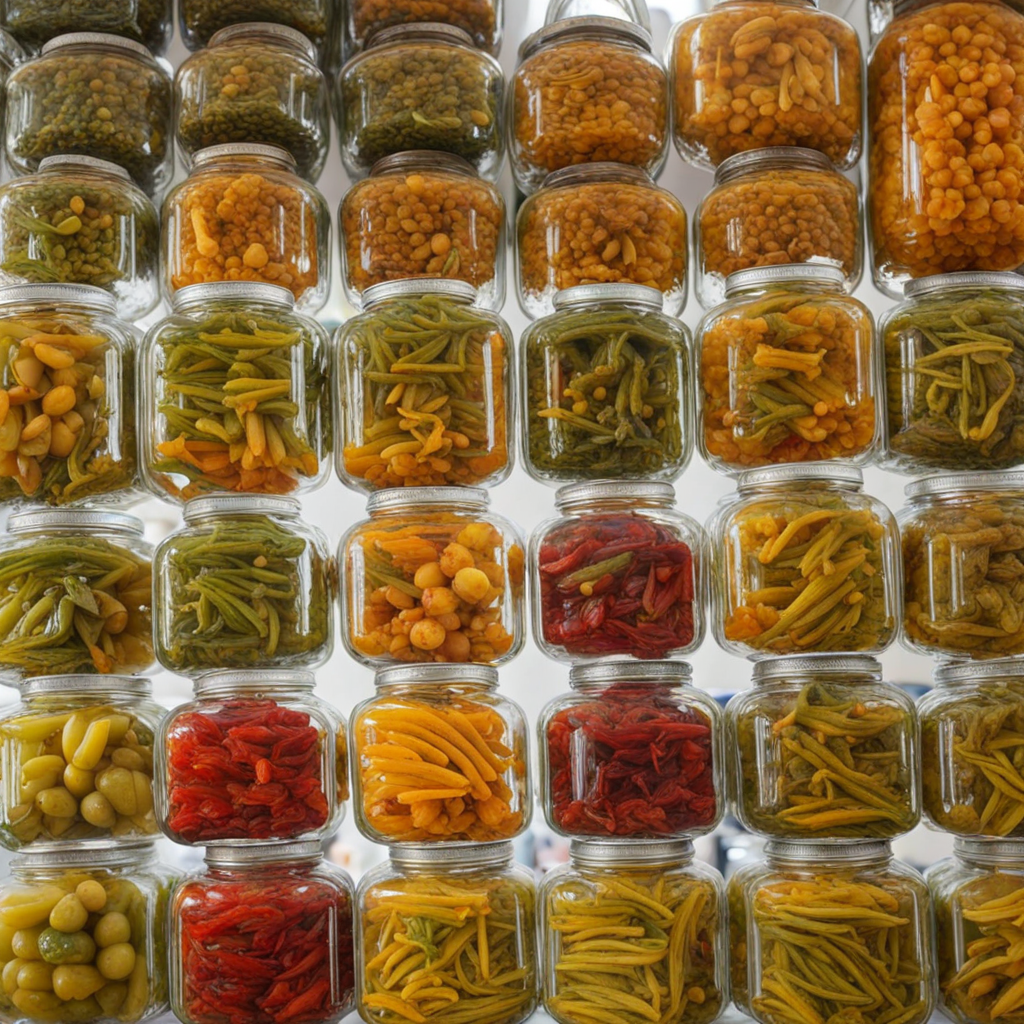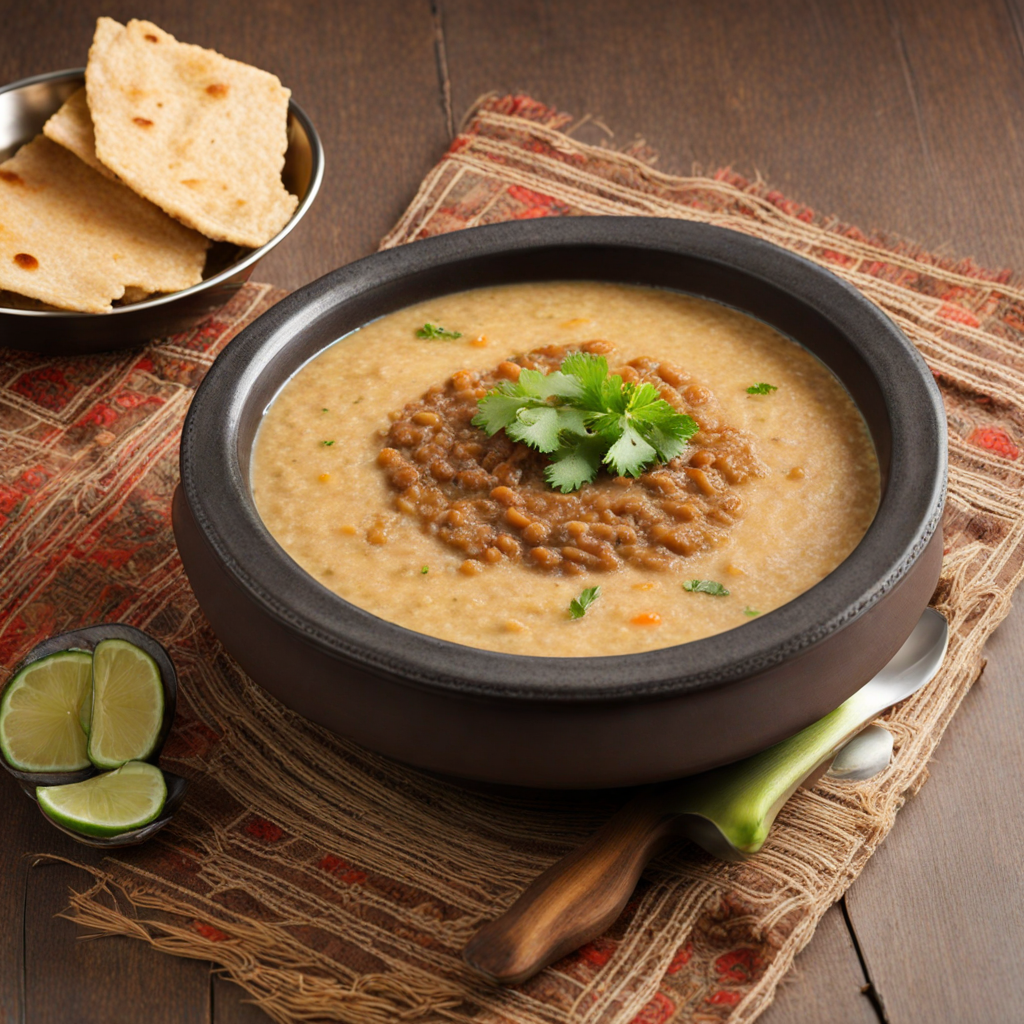Jalebi
Jalebi is a beloved sweet treat from Pakistan that dazzles with its vibrant orange hue and intricate spiral shape. This delicious confection is made by deep-frying a fermented batter of all-purpose flour and then soaking it in a fragrant sugar syrup infused with cardamom and rose water. The result is a crispy exterior that gives way to a chewy, syrup-soaked interior that bursts with flavor in every bite. The texture is a delightful contrast, making it a favorite among those with a sweet tooth. Traditionally, jalebi is enjoyed warm and can be found at street vendors and local sweet shops throughout Pakistan. It is often paired with a side of milky chai or yogurt, which complements the sweetness and adds a creamy richness to the experience. The syrup's aromatic notes of cardamom and the floral undertones of rose water elevate the dish, creating a taste that is both indulgent and comforting, perfect for festive occasions or as a casual snack. This sweet treat is not just a dessert but a cultural icon in Pakistan, often served during celebrations, weddings, and religious festivals. Its vibrant color and unique presentation make it visually stunning, ensuring it captures the attention of those who encounter it. For anyone looking to explore the depths of South Asian cuisine, tasting jalebi is a must, as it offers a glimpse into the rich culinary traditions of Pakistan, where sweets play a central role in hospitality and celebration.
How It Became This Dish
The Sweet Journey of جلیبی: A Cultural Delight of Pakistan Origins and Early History جلیبی, pronounced "jalebi," is a traditional sweet that holds a cherished place in the culinary landscape of Pakistan and the Indian subcontinent. The origins of jalebi can be traced back to ancient times, with some historians suggesting that it may have roots in the Middle Eastern dish known as "zoolabia." This sweet treat has undergone various transformations over the centuries, reflecting the rich tapestry of cultural influences that have shaped the region. The earliest references to a sweet similar to jalebi can be found in Persian literature, where it is mentioned as a delicacy enjoyed by royalty. The dessert made its way to the Indian subcontinent through trade routes and cultural exchanges, especially during the Mughal era (16th to 18th centuries). The Mughals, known for their opulent feasts and lavish banquets, played a pivotal role in popularizing jalebi, which became a staple at celebrations and festivals. Cultural Significance In Pakistan, jalebi is more than just a sweet; it is a symbol of joy and festivity. It is commonly served during weddings, religious celebrations like Eid, and other special occasions. The bright orange color and crispy texture of jalebi make it visually appealing, and its syrupy sweetness tantalizes the taste buds. The preparation of jalebi often involves family gatherings, where relatives come together to help in the frying and dipping process, creating a sense of community and togetherness. Jalebi holds a special place in the hearts of both young and old. For many, it evokes nostalgia, reminding them of childhood memories of street vendors selling freshly made jalebi, the tantalizing aroma wafting through the air. It is often paired with savory snacks like samosas and kachoris, creating a delightful contrast of flavors that enhances the culinary experience. The Making of Jalebi The preparation of jalebi is an art form that requires skill and precision. Traditionally, the batter is made from fermented wheat flour, which is mixed with yogurt and water to create a smooth, flowing consistency. The batter is then placed in a cloth bag with a small hole at the end, allowing it to be piped into hot oil in intricate spiral shapes. Once fried to a golden brown, the jalebi is immersed in a warm sugar syrup flavored with cardamom and saffron, enhancing its sweetness and aroma. Over time, variations of jalebi have emerged, with different regions adding their unique twist to the recipe. In some areas, jalebi is made with besan (gram flour) instead of wheat flour, resulting in a slightly different texture. Others may incorporate flavors such as rosewater or lemon to create a distinct taste. Despite these variations, the essence of jalebi remains the same—a deliciously sweet treat that brings people together. Evolution Through Time As the years went by, jalebi continued to evolve, adapting to changing tastes and culinary innovations. With the advent of modern technology, the process of making jalebi has become more accessible. While traditional methods are still cherished, many home cooks now use electric fryers and pre-packaged mixes to save time. However, the essence of jalebi—the joy of creating it and sharing it with loved ones—remains unchanged. The rise of globalization has also brought jalebi to international shores, introducing this beloved sweet to new audiences. Pakistani diaspora communities around the world have embraced jalebi as a way to celebrate their heritage, often serving it at cultural events and gatherings. Food festivals and international fairs frequently feature jalebi, allowing people from diverse backgrounds to experience the sweetness that has transcended borders. Jalebi in Modern Pakistan In contemporary Pakistan, jalebi continues to be a staple at festivals, weddings, and family gatherings. Street vendors, known as "jalebi walas," can be found in bustling markets and roadside stalls, expertly frying and dipping jalebi in syrup. These vendors have become an integral part of the urban landscape, drawing crowds with their tantalizing displays and the irresistible aroma of freshly cooked jalebi. Moreover, social media has played a significant role in popularizing jalebi among younger generations. Instagram and TikTok have become platforms for food enthusiasts to share their love for this sweet treat, showcasing creative presentations and unique serving suggestions. The visual appeal of jalebi, with its vibrant color and intricate shapes, makes it a perfect subject for food photography, further fueling its popularity online. Conclusion: A Sweet Legacy In conclusion, jalebi is not merely a dessert; it embodies the rich cultural heritage of Pakistan and the Indian subcontinent. Its origins, deeply rooted in history, have allowed it to evolve and adapt over time while retaining its significance as a symbol of celebration and community. From the streets of Lahore to the kitchens of families around the world, jalebi continues to bring people together, evoking nostalgia and joy with every bite. As we celebrate the legacy of jalebi, we are reminded of the power of food to bridge cultures and create connections. Whether enjoyed with a cup of chai on a rainy day or as part of a grand feast, jalebi remains a timeless delight that will continue to sweeten lives for generations to come. The journey of jalebi is a testament to the enduring spirit of culinary traditions and the joy of sharing good food with loved ones.
You may like
Discover local flavors from Pakistan


